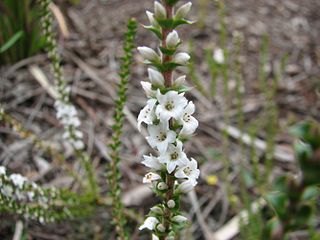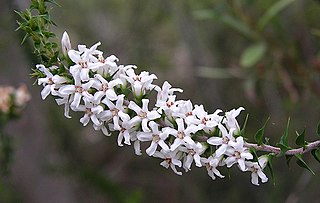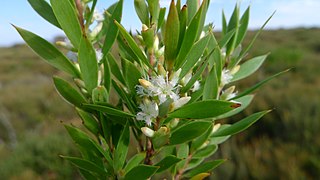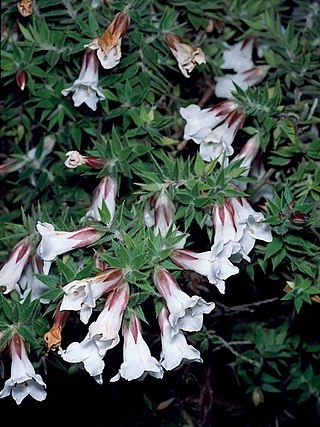
Epacris gunnii is a species of flowering plant in the family Ericaceae and is endemic to south-eastern Australia. It is an erect shrub with hairy branchlets, concave, sharply-pointed, broadly egg-shaped leaves, and tube-shaped, white flowers arranged along the stems.

Epacris pulchella, commonly known as wallum heath or coral heath is a species of flowering plant in the family Ericaceae and is endemic to eastern Australia. It is a slender, erect shrub with egg-shaped, pointed leaves and white or pinkish, tube-shaped flowers.

Leucopogon fletcheri is a species of flowering plant in the heath family Ericaceae and is endemic to south-eastern continental Australia. It is a densely-branched shrub with sharply-pointed oblong leaves, and pendent, tube-shaped white flowers in pairs in upper leaf axils.

Epacris reclinata, commonly known as fuchsia heath, is a species of flowering plant in the family Ericaceae and is endemic to eastern New South Wales. It is a low-lying to spreading shrub with egg-shaped leaves and pink to red, tube-shaped flowers, sometimes with lighter tips.

Leucopogon esquamatus, commonly known as the swamp beard-heath, is a species of flowering plant in the heath family Ericaceae and is endemic to south-eastern Australia. It is a slender shrub with mainly elliptic leaves, and short-lived white, tube-shaped flowers arranged singly or in pairs in upper leaf axils.

Epacris muelleri, commonly known as Mueller's heath, is a species of flowering plant in the heath family Ericaceae and is endemic to eastern New South Wales. It is an erect, or weak straggling shrub with more or less glabrous branchlets, elliptic leaves and white or cream-coloured, tube-shaped flowers.

Epacris browniae is a species of flowering plant in the heath family Ericaceae and is endemic to a small area of New South Wales. It is an erect, woody shrub with wand-like branchlets, crowded, glabrous, trowel-shaped leaves and tube-shaped flowers with white petals.

Leptospermum benwellii is a species of shrub that is endemic to the Nymboida National Park in New South Wales. It has smooth bark, young branches with conspicuous flanges, narrow elliptical leaves, white flowers and thin-walled, bell-shaped to hemispherical fruit.

Leptospermum brachyandrum is a species of shrub or small tree that is endemic to eastern Australia. It has smooth bark, linear to lance-shaped leaves and white flowers and usually grows along creeks, often in water.

Prostanthera hindii is a species of flowering plant in the family Lamiaceae and is endemic to the Central Tablelands of New South Wales. It is a small, erect shrub with densely hairy branches, egg-shaped leaves, and mauve flowers with deep mauve to dark purple colouration inside the petal tube.

Epacris gnidioides, commonly known as Budawangs cliff-heath, is a species of flowering plant in the heath family Ericaceae and is endemic to a restricted area of New South Wales. It is a small, creeping shrub with hairy branches, sharply-pointed lance-shaped leaves, and tube-shaped, white flowers.

Pomaderris ledifolia, commonly known as Sydney pomaderris, is a species of flowering plant in the family Rhamnaceae and is endemic to south-eastern continental Australia. It is an erect, delicate shrub with hairy young stems, narrowly elliptic to lance-shaped leaves, and compact clusters of yellow flowers.
Epacris apsleyensis is a species of flowering plant in the heath family Ericaceae and is endemic to a small area of Tasmania. It is an erect shrub with hairy branchlets, lance-shaped to elliptic leaves and tube-shaped flowers with white petals.

Epacris coriacea is a species of flowering plant in the heath family Ericaceae and is endemic to a eastern New South Wales. It is a slender, erect shrub with hairy branchlets, egg-shaped to more or less diamond-shaped leaves and tube-shaped, white or cream-coloured flowers.

Epacris decumbens is a species of flowering plant in the heath family Ericaceae and is endemic to a restricted area of New South Wales. It is a straggling, low-lying shrub with hairy branchlets, elliptic to egg-shaped leaves, and tube-shaped, white flowers.

Epacris glabella, commonly known as smooth heath, is a species of flowering plant in the heath family, Ericaceae, and is endemic to Tasmania. It is a shrub with erect branches, egg-shaped to elliptic leaves and white, tube-shaped flowers.

Epacris hamiltonii is a species of flowering plant in the family Ericaceae and is endemic to the Blue Mountains in New South Wales. It is a slender, low-lying to ascending shrub with hairy branchlets, thin, flat, hairy egg-shaped leaves, and white, tube-shaped flowers arranged in small groups at the end of branches.
Epacris pilosa is a species of flowering plant in the heath family Ericaceae and is endemic to eastern New South Wales. It is low-lying shrub with weeping, shaggy-hairy branchlets, elliptic to more or less egg-shaped leaves and white or cream-coloured tube-shaped flowers.
Epacris rigida is a species of flowering plant in the family Ericaceae and is endemic to eastern New South Wales. It is an erect, bushy shrub with elliptic leaves and white or cream-coloured, tube-shaped flowers.

Leucopogon gelidus is a species of flowering plant in the heath family Ericaceae and is native to south-eastern continental Australia. It is a slender, compact shrub with elliptic to egg-shaped leaves, and spikes of drooping, tube-shaped white flowers.

















